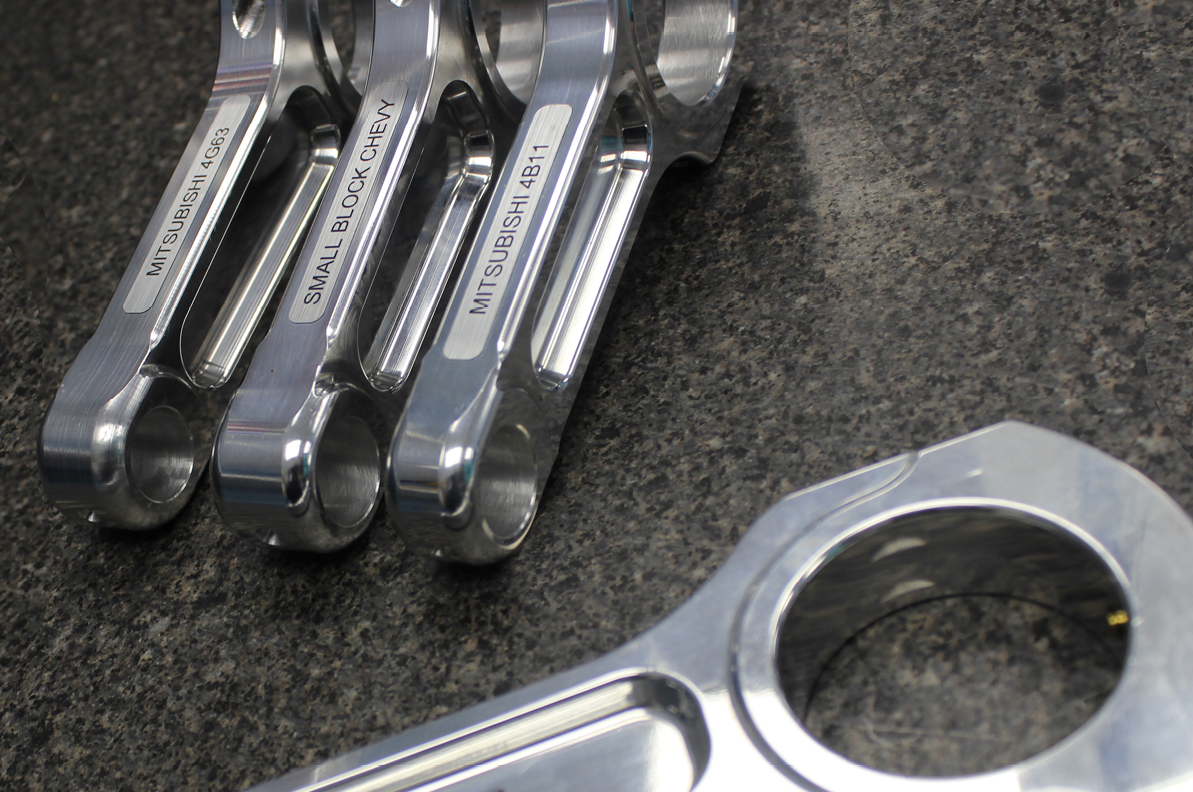We use genuine ARP 8740, ARP 2000, ARP L19, or ARP Custom Age 625 bolts exclusively.
You may ask, why are R&R’s rods made out of billets and not forgings. It is often believed nothing is better than a forged connecting rod. Even though our rods are manufactured out of what looks like a square stock, it should not be confused for a casting or a plate.
Unlike a forging in which the aluminum is literally pounded into the shape of a rod, our material is is cold worked, forced through a die at extreme pressures, to form the billets from which the Aluminum Connecting Rods are CNC’ed from. This work hardening builds the strength, grain structure, elasticity, and general characteristics that make our Aluminum Connecting Rods superior to common forgings. Our alloy is then further artificially aged and heat treated, then stress relieved though additional manufacturing processes.
Why do I need an aluminum connecting rod in my engine?
On many high horsepower engines, an aluminum connecting rod acts like a shock absorber between the piston and the crankshaft. Without this cushion, the bearings may flatten, the crankshaft may crack, or the main caps will start walking/shuffling or even break. Using an aluminum connecting rod ensures that all these components can withstand the stresses of a high horsepower engine.
What is the difference between a forged and aluminum connecting rod?
Forgings are easier and cheaper to manufacture and until CNC machining became popular, this was the only economical way to manufacture an aluminum connecting rod. Billets actually cost more, but the finished product is actually stronger and lasts longer. Part of this is due to how the billets are manufactured, as extrusions allow for directionality of the grain structure, adding to how well Aluminum Connecting Rods function as a shock absorber. Same goes with a forged versus billet crankshaft – billet is always better!
What clearances do I need to run with an aluminum connecting rod?
When running an aluminum connecting rod, your running clearances need to be adjusted as the aluminum connecting rod will grow more than a steel rod. A piston to head clearance of .060″ minimum is recommended. Sides clearances need to be increased by .002-.005″ over the steel counterpart depending on application and oil viscosity used. Wrist pins typically need to be run tighter than their steel counterpart as the heat from the piston transfers to the rod and increases running clearances during operation. Rod bearing clearances typically are run .001-.002″ looser than with steel rods as the parting lines tend to burnish into each other during initial operation. Aluminum connecting rod to camshaft and engine block clearances should also be kept to a minimum of .060″.
Can I run my Aluminum Connecting Rods without a pin end bushing or can the pins be press fit?
You cannot run a press-fit pin on an aluminum connecting rod, but for most applications, we recommend not using a pin end bushing, as the aluminum is an excellent bearing surface and bushings tend to come loose when the pin end of the rod is heated. We recommend you send your wrist pins to us for final pin fit.
What bearings do I run with an aluminum connecting rod?
Many race bearings are offered for numerous applications with dowel pin holes already drilled in them. Tangs were not intended to prevent bearings from spinning. They are just used to locate the bearing side to side. As the aluminum connecting rod grows more than a steel rod, the bearing bore actually grows enough to allow the bearing to become looser than bearing manufacturer recommendation, requiring that a dowel is used to secure the bearing in location. If your bearings are not offered drilled for your application, R&R can modify them for you for a small fee.
Do I need to pre-heat my oil when running an aluminum connecting rod?
No, but it is always good practice to get the engine up to operating temperature before subjecting it to high loads. This will provide longer life for all engine components. As aluminum heats up, it actually looses tensile strength, but gains ductility, which aides in its function to act like a shock absorber without breaking. Aluminum Connecting Rods that fail before their life cycle typically are subjected to stresses prior to being fully warmed up.
Can an aluminum connecting rod be rebuilt?
While yes we can resize both the pin end and the big end of the rod, usually aluminum will stress fracture long before this is needed and should be replaced as a maintenance item.
What aluminum connecting rod bolts should I use?
We exclusively use ARP rod bolts in all of our Aluminum Connecting Rods, ranging from ARP 8740 up to Custom Age 625. Most Aluminum Connecting Rods use ARP 2000 or ARP L19, but call us and we’ll help you figure out the right rod bolt for your application.
Can I upgrade my aluminum connecting rod bolts in an existing rod?
No. Once the big end has been sized and honed, the same part number bolt with the same torque spec must be used.
How often do I need to change my Aluminum Connecting Rods?
As mentioned before, an aluminum connecting rod acts like a shock absorber. There are only so many cycles even a shock absorber can withstand before it can’t rebound further. Even though many customers say our rods last longer than other Aluminum Connecting Rods they have used in the past, this totally depends on the application and how the engine is treated. The best we can do is report back what our customers tell us. In street use, people report over 15,000 miles of mixed street/strip use on applications with high boost. The key is to replace the rod before it fatigues, so it’s best to speak to your engine builder or search the internet forums for what other people are reporting.
Do I want to use the torque or stretch method for tightening my rod bolts?
The stretch method is always better, but sometimes you are unable to do it or don’t have the time to do it between races. If your stretch method specification is not shown above, please call, as this information is available. Additionally, when using the stretch method, it is possible to check for a rod bolt that has gone bad, as it will not come back to its original length measurement, as it remains permanently stretched beyond its elastic limit.
I hear so many things about Aluminum Connecting Rods. What is myth and what is fact?
My Aluminum Connecting Rods are stretched. Answer: Myth. Many people say their Aluminum Connecting Rods have stretched. They actually grow while hot and contract to their original length when cooled back to room temperature. The only way they can become longer is if they are deformed or fractured either from an engine failure or past their end of life cycle.
Aluminum Connecting Rods are only for drag racing. Answer: Myth. In some drag racing applications, Aluminum Connecting Rods have to be changed after only a few passes, and in other cases, they have run for years or thousands of passes. We even have customers that use them in their street cars and diesel engines as our material has been engineered to have excellent fatigue characteristics which lend them for longer service life.
Aluminum Connecting Rods aren’t good for circle track engines. Answer: Myth. While not common, we do have numerous people using them with great success.
Aluminum Connecting Rods aren’t good for diesel engines. Answer: Myth. While this is also not common, we have been doing this for years on John Deere, International, and Duramax engines with excellent results. As with any application, these rods must be changed out before their end of life cycle.
Aluminum Connecting Rods aren’t good for land speed race engines. Answer: Myth. Aluminum Connecting Rods can handle sustained high rpm usage as there is only one heat cycle in a land speed race. Remember, it is heat cycles that shorten the life expectancy of an aluminum connecting rod.
Do Aluminum Connecting Rods break or any rods break? Answer: True. If you exceed the horsepower rating that the connecting rod was designed for or exceed the life cycle of the aluminum, the rod will break, we can guarantee that! Good example of this is titanium rods in road race engines are usually cycled out every 40-80 hours!
Ready to order? Call Mike at (815) 465-6741 for immediate assistance with placing your order.
R&R Pro custom Aluminum Connecting Rods have been engineered to be the best in the industry and are available for these and many other applications:
Caterpillar, John Deere, International, Farmall, Buda, Cockshutt, White, Minneapolis Moline, Allis-Chalmers, Cummins, Powerstroke, Duramax, Porsche, Mitsubishi, Honda, Chevrolet GMC, Chrysler Dodge Jeep, Ferrari Maserati, Fiat, Volkswagen, Volvo, BMW, Kia, Toyota Lexus Scion, Hyundai, Mercedes, Audi, Isuzu, Bentley, Jaguar, Lamborghini, Nissan Infinity, Suzuki, Subaru, Rolls Royce, Mazda, Winton, MG, Can-Am, Lotus, Austin Healey, Lancia, Mini, Austin Martin, Alfa-Romeo, Triumph, Bugatti, Buick, Oldsmobile, Pontiac, Packard, Pierce Arrow, Studebaker, Duesenberg, Cadillac, Ford, Cord, Morgan, Auburn, Generac, Kawasaki, Briggs and Stratton, Kohler, Deutz, Peugeot, and countless others.
If we haven’t done it, just send us a sample or fill out our custom connecting rod order form.




